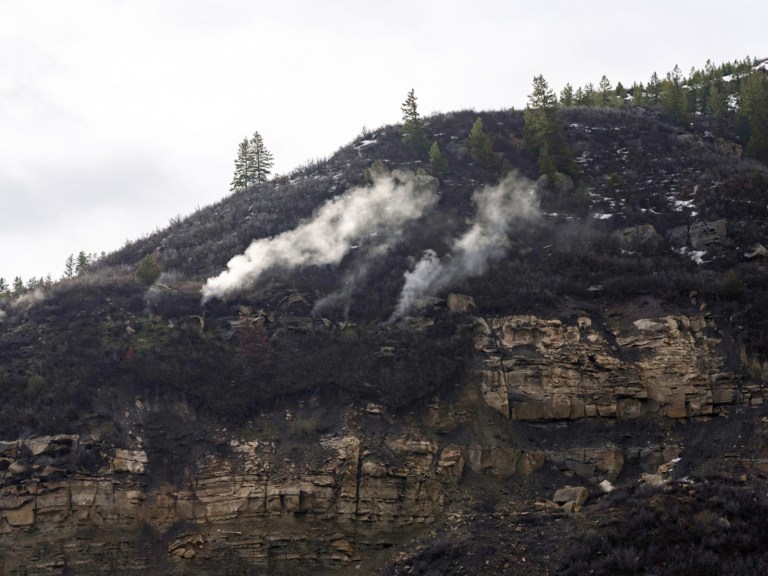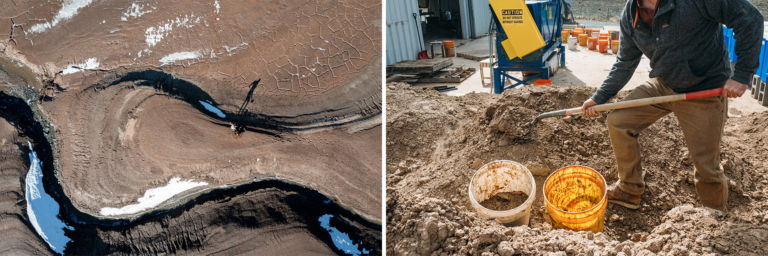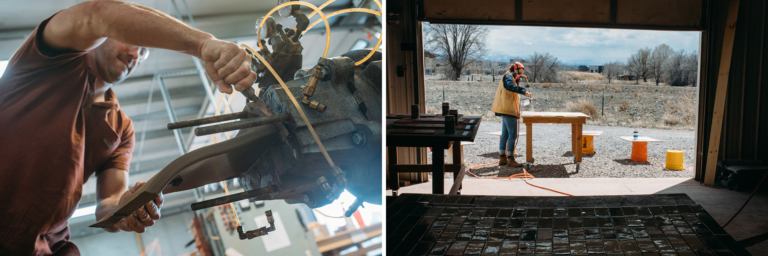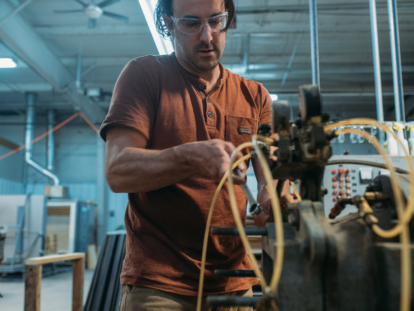A Man, Mud and Methane
A look inside Delta Brick & Climate Company, where doing is undoing.
All photos by Steven Gnam
Consider the common brick: made of simple clay and silt, roughly the weight of a half-gallon of milk and honest as a loaf of bread. It’s a building block in humanity’s story. Making bricks by utilizing natural, local clay supplies is nothing new. In the ancient Sumerian ruins of Uruk, you can still find kiln-fired bricks that are as sound as the day they were made.
In 2017, bricks were the furthest thing from Chris Caskey’s mind. He was working as a faculty chemist at the Colorado School of Mines in Golden, Colorado, where he focused on CO₂ capture, the process of grabbing and sequestering carbon dioxide before it enters the atmosphere. Thirty-two-years old and a bit restless at the time, Caskey got wind of a problem plaguing the western slope of Colorado: hundreds of abandoned and decommissioned coal mines gushing invisible and harmful methane into the air at a rate equivalent to the daily emissions from 100,000 vehicles. Every day, 1.3 million cubic feet of methane, a greenhouse gas over 25 times more potent than carbon dioxide, escapes from underground coal deposits and surrounding rock strata due to mining activity.
“I was excited about the potential to work with methane,” Caskey told me over the phone one afternoon, his extended vowels placing his accent as more West Coast “bruh” than his native Arizona. He’d moved to Golden to attend university at the Colorado School of Mines and became embedded in the state’s lifestyle—trail running, avid cycling, craft beer. “CO₂ capture is essentially just storage,” he said. “But methane—it’s potent, and there’s still energy in those molecules.”
Caskey joined the North Fork Coal Mine Methane Working Group in 2016 where he learned more about mitigation strategies for high emissions of methane from coal mining. “When I started thinking about all the methane down there, and all that could be done with that energy,” he recalls, “I was instantly trying to figure out how many problems I could point at each other.” He didn’t have to look far.

Caskey often combines his trail runs with methane leak scouting, using imaging equipment to detect leaks that aren’t as visible as these. Delta County, Colorado.
In a narrow canyon just up the road from the mines, the Paonia Reservoir poses a different human-caused problem. Built in the late 1950s to serve as irrigation storage for the valley’s farms and ranches, the reservoir became clogged with clay sediment from the aptly named Muddy Creek, reducing water storage for crops downstream. In the winter of 2017, Caskey acted on a hunch and strapped on the only “hiking shoes” he had at the time, cross-country ski boots, and slid down the icy embankment to the reservoir’s flats, chipped out a frozen sediment sample and hurried it back to his lab at the School of Mines. His suspicions were confirmed: The mud turned out to be high-quality clay that could be used for ceramics and building materials.
Caskey had been thinking about the problem mud in the reservoir because he was interested in sustainable building, like straw-bale homes. He wondered if he could use the mud for that, but then it hit him like a ton of bricks—he could make bricks and tiles from the mud. His vision was to restore water storage by dredging the mud and using it to make bricks and tiles fired in a factory powered by the captured methane from nearby mines.
Caskey took a sandwich bag of Paonia Reservoir mud to the National Brick Research Center in South Carolina, where brick experts rubbed it in their hands, smelled it, tasted it and signed off on its integrity as a building material. He raised the initial seed money, bought an extruder (a big machine essential for processing the mud into usable bricks and tiles), rented a warehouse, bought some used kilns, hired employees and set up shop as the Delta Brick & Climate Company (DBCC).

Left: The Paonia Reservoir, clogged with dirt deposited by Muddy Creek, is Delta Brick & Climate Company’s source of brick- and tile-making materials. Delta County, Colorado.
Right: Caskey shovels Paonia Reservoir mud into the mixer. He recalls the early days with a pained look, when they mixed sediment, grog and water by hand. Montrose, Colorado.
I joined the DBCC crew on a warm Saturday morning in late June. The factory occupies a former bus depot on the west end of Montrose, a high desert town just down the valley from the mining areas. Country music echoes loudly in the large open room that houses all the tools and equipment, and a crew of six employees in clay-stained workwear is busy making bricks and tiles—extruding clay, cutting, drying, firing, glazing and packing.
Holly Williamson, Caskey’s wife, stands at a tall worktable packaging hexagonal white tile. A product marketing manager for another company, she has been instrumental in DBCC’s visioning and start-up, building its online presence and sleek website. She also helped to hip up the company’s custom tile line, Particular Tile, with modern, on-trend colors that are beginning to appear in showrooms and boutique design stores in Colorado. Tile was initially DBCC’s biggest seller, with orders coming in from across the US and as far away as Alaska. But a recent order of 11,000 brick pavers for a new municipal library being built in Gunnison, Colorado, has shifted production to the more labor-intensive brick making. It’s their biggest order yet.
“That’s 500 bricks we need to make a day!” Caskey yells brightly across the floor. Two young production workers, Nathan and Sam, overexaggerate groans before resuming their work operating a large, circular pneumatic brick cutter—a two-man job that they execute like athletes in a weight room.

Left: Caskey works the extruder, a Play-Doh fun factory for the big kids.
Right: Nina Steigele sprays tiles before sending them back to the kiln for a final firing. Montrose, Colorado.
Nina Steigele, DBCC’s production lead and head ceramicist shows me around, starting with unremarkable piles of dirt—the Paonia Reservoir sediment. In the beginning, Caskey somewhat-illegally hand-dredged loads of it into 5-gallon buckets before receiving blessings, permits and funding from the state to perform large-scale dredging. Today, Eric Edwards, a 60-something former coal miner, scoops large loads from the reservoir with a skid steer and trucks it 60 miles to the factory.
Steigele shovels sediment into a 5-gallon bucket, adds just the right amount of water and grog, and dumps it in the mixer. Once blended, she thumbs the mixture several times to make sure it’s the right consistency. “There are no absolutes in this work,” she says, wiping the clay onto her work pants. “Even seasonal changes in temperatures can affect the consistency. We just adjust and pivot as needed. This work is all creative problem solving, all the time.”
Steigele loads the exacted mix into the extruder where it’s condensed to remove air pockets before being pressed, like a Play-Doh fun factory, into ribbons of tile or columns of brick, depending on the fitting. She hands me a newly pressed brick, still wet. It’s surprisingly sleek and dark and feels almost animal in its density. It will spend up to two weeks in a gradual drying process, first under plastic, then in the open air before kiln firing and emerging rosy terracotta, ready to be put to use.

Caskey named his company in homage to the Delta Brick & Tile Company, a brickyard that operated in neighboring Delta County in the early 1900s and mined a brilliant palomino-yellow clay reminiscent of the area’s prized sweet corn. Stately blond-brick buildings in Delta and surrounding towns stand testament to Western Colorado’s early brickworks industry.
At lunchtime, we sit under a large Russian elm tree eating pizza. Nathan, a student and member of the diving team at the University of Denver, passes his phone around to show videos of high-level belly flops and elegant, no-splash dives. At one point, he stands and does a tight backflip. We applaud. Sam, a student at Montrose High School talks about his friends working for less money at nearby fast-food restaurants. “They’re not learning anything, and they’re not getting jacked,” he says, rubbing his right bicep. He and Nathan look at each other and laugh, their young faces pink from the sun. It strikes me that in our current digital reality, their experience learning a tough yet sustainable trade is a rarity, beautiful for not only its legacy but also its promise for the future.
After lunch, the crew gets back to their brick quota. It’s hot, and the work is intense, but the crew remains upbeat. The next step for DBCC is building a factory outside of Paonia that will use captured methane to power their facility and kilns. Caskey is about to sign a contract on a piece of land that abuts the North Fork Gunnison River, where he plans to break ground next spring and actualize his hat trick of environmental problem-solving.
Editor’s Note: All dams are dirty. The Paonia Dam, mentioned in this story, was completed in 1962 with a “sediment design life” of 50 years. The designers’ planned obsolescence relied on passing the problem of building a replacement dam to the next generation, the environment be damned.

